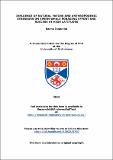Influence of natural factors and anthropogenic stressors on sperm whale foraging effort and success at high latitudes
Abstract
Behavioural responses can reveal important fitness trade-offs and ecological traps in evolutionarily novel contexts created by anthropogenic stimuli, and are of increasing conservation concern due to possible links to population-level impacts. This thesis illustrates the use of proxies for energy acquisition and expenditure within multivariate and state-based modelling approaches to quantify the relative time and energetic costs of behavioural disturbance for a deep-diving marine mammal (Physeter macrocephalus) in foraging grounds in Kaikoura Canyon (New Zealand) and near Lofoten Islands (Norway). A conceptual framework is first developed to identify and explore links between individual motivation, condition and external constraints to behavioural disturbance [Chapter 1]. The following chapters then use data from behavioural response studies (BRS) to: 1) derive biologically relevant metrics of behaviour [all chapters], 2) investigate effects of boat-based focal follows and tagging procedures [Chapters 2-3], and 3) relate responses to specific disturbance stimuli (distance, approach, noise) from whale-watching [Chapter 2], naval sonar and playback of presumed natural predator (killer whale Orcinus orca) sounds [Chapter 4]. A novel hidden state model was developed to estimate behavioural budgets of tagged sperm whales from multiple streams of biologging (DTAG) data [Chapter 3]. Sperm whales traded off time spent at foraging depths in a non-foraging and non-resting state in response to both tag boat presence, 1-2 kHz naval sonar (SPL 131-165 rms re 1μPa) and mammal-eating killer whale sound playbacks, indicating that parallel non-lethal costs were incurred in both anthropogenic disturbance and presumed antipredatory contexts. While behavioural responses were highly variable by individual, biologically informed state-based models appeared effective to control for variability in energy proxies across different functional contexts. These results and Chapter 5 “linking buzzes to prey” demonstrate that behavioural context is a signal that can aid understanding of how individual non-lethal disturbance responses can impact fitness.
Type
Thesis, PhD Doctor of Philosophy
Collections
Items in the St Andrews Research Repository are protected by copyright, with all rights reserved, unless otherwise indicated.

